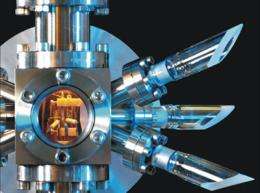The tick-tock of the optical clock

(PhysOrg.com) -- UK's National Physical Laboratory time scientists have made an accurate measurement of the highly forbidden octupole transition frequency in an ytterbium ion, which could be used as the basis for the next generation of optical atomic clocks.
Ytterbium (Yb) is a metallic element that could be used in ultra-high accuracy optical clocks. Atomic clocks that use the microwave frequency of caesium atoms are currently the gold standard when it comes to timekeeping, with NPL's caesium fountain clock being the UK's primary standard and currently the most accurate system of its kind in the world. But clocks that rely on optical frequencies, such as those based on that of ytterbium, have the potential to surpass microwave atomic clocks, with up to 100 times better stability and accuracy.
In research at NPL, published in the New Journal of Physics, a measurement of the frequency of a transition of an ytterbium ion, known as an octupole transition, is presented with a level of uncertainty of one part in 1015. This represents an improvement by a factor of 20 on the previous measurement and agrees with a similar measurement made by the German National Measurement Institute, PTB, and published soon after the NPL paper, with an uncertainty of 0.8 parts in 1015. In fact, the results demonstrate the best international agreement between trapped ion optical frequency standards to date.
The measurement of the frequency is important because in simplistic terms it is this frequency that determines the rate at which the atomic clock 'ticks'. In general, the faster the rate of ticking, the more precisely time intervals can be measured. The definition of the second comes from the time taken for 9,192,631,770 such ticks in a caesium atom. The recent research at NPL measured that during one second, the ytterbium ion clock underwent 642,121,496,772,646.22(67) oscillations, corresponding to a tick rate nearly five orders of magnitude higher than in caesium.
Various upgrades to the experimental equipment have enabled this accurate measurement to be made. Most significantly, an improved diode-based probe laser has been implemented that allows the clock to operate for extended periods of time at the required frequency. It is thought that the uncertainty can be further reduced by decreasing the impact of any drift in the magnetic field. One way of doing this would be to introduce a magnetic shield made from mu-metal - a nickel-iron alloy famed for its high magnetic permeability - around the ion trap.
By introducing the magnetic shielding and making several other identified improvements, the uncertainty for the ytterbium standard could be further reduced to below the level of one part in 1017. At this level of uncertainty, the ytterbium ion standard would be a strong candidate for a future redefinition of the SI-second, replacing the caesium based definition that we use today.
More information: S A King, et al, P E G Baird and P Gill, New J. Phys. 14, 013045 (2012)
N. Huntemann, et al., Phys. Rev. Lett. 108, 090801 (2012)
Provided by National Physical Laboratory

















